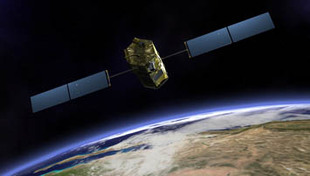Jan 29 2009
The first global maps of atmospheric carbon dioxide levels based on data from NASA's Orbiting Carbon Observatory will be created by a University of Michigan researcher and her colleagues.
 The Orbiting Carbon Observatory (OCO) will collect precise global measurements of carbon dioxide in Earth's atmosphere
The Orbiting Carbon Observatory (OCO) will collect precise global measurements of carbon dioxide in Earth's atmosphere
The team will use sophisticated mathematical techniques to fill information gaps between the satellite's direct measurements, the closest of which will be 93 miles apart at the equator.
Leading the carbon cartographers is Anna Michalak, an assistant professor in the Department of Civil and Environmental Engineering and the Department of Atmospheric, Oceanic and Space Sciences.
OCO is scheduled to launch Feb. 23. As the first NASA satellite designed exclusively to study carbon dioxide, OCO's data, along with Michalak's maps, will provide unprecedented detail about this greenhouse gas in the atmosphere.
OCO will clarify how levels of carbon dioxide fluctuate across continents, oceans, and seasons. It will work to identify the sources and sinks of carbon across the globe. Natural sinks are places that soak up CO2, such as plants and some areas of the oceans. Understanding the Earth's natural uptakes and emissions of carbon is critical to predicting the planet's future climate.
Michalak and her colleagues' work will involve filling the information gaps between the OCO's measurement points without introducing assumptions that could obscure the results.
"Our job is really to understand the information content of the data and milk it for all it's worth, without pretending to know things we don't," Michalak said.
OCO will orbit from pole to pole, taking advantage of Earth's rotation to maximize its coverage. Each day, it will capture data from approximately 16 strips of the globe, each 10 kilometers, or 6.2 miles, wide. Every 16 days, it will return to the same place, Michalak said.
"While the OCO can measure the concentrations of carbon in the atmosphere with unprecedented detail, it can't look everywhere," she said. "Even after 16 days, the closest measured strips will be 150 kilometers apart at the equator. Also, OCO cannot see through clouds and atmospheric aerosols. Most of the world will not be directly measured."
Michalak and her colleagues will use sophisticated geostatistical modeling tools to interpolate information about the places in between OCO's measurements. An important part of their process involves using OCO data to determine how much carbon dioxide levels fluctuate across the globe. Knowing this variability will help them paint their full picture.
The scientists' tools will also tell them how certain they can be of how accurate their gap fills are in different parts of the planet.
The finished carbon maps could help solve an enduring mystery. Levels of carbon dioxide in the air have steadily increased since the Industrial Revolution. But remarkably, these atmospheric concentrations have not spiked as dramatically as emissions.
While humans emit about 8 billion tons of carbon into the atmosphere each year by burning fossil fuels, only about 4 billion tons end up in the air. Oceans likely sequester 2 billion tons of what's missing. But that leaves 2 billion tons---25 percent---of the carbon humans emit into the atmosphere unaccounted for.
Plants are likely taking it up, Michalak says, but scientists don't know exactly where or why. Answers to such questions would help scientists predict how the carbon cycle will evolve. Studies have demonstrated that plants exposed to additional CO2 take up more of it and grow faster for a time. But then they revert to their previous behavior.
"Fundamentally, what we're trying to do is understand why and how and when and where plants and oceans are taking up carbon so that we can predict how this will change in the future. Once we have the ability to predict what happens in the future, this will allow us to design strategies for better carbon management and for dealing with climate change," Michalak said.
This research is funded by NASA.
Michalak is a fellow in the Michigan Memorial Phoenix Energy Institute, which develops, coordinates and promotes multidisciplinary energy research and education at U-M.
For more information on Michalak, visit: http://www.ns.umich.edu/htdocs/public/experts/ExpDisplay.php?ExpID=1381